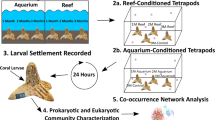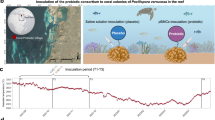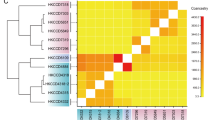Abstract
Associations between healthy adult reef-building corals and bacteria and archaea have been observed in many coral species, but the initiation of their association is not understood. We investigated the onset of association between microorganisms and Pocillopora meandrina, a coral that vertically seeds its eggs with symbiotic dinoflagellates before spawning. We compared the bacterial communities associated with prespawned oocyte bundles, spawned eggs, and week old planulae using multivariate analyses of terminal restriction fragment length polymorphisms of SSU rRNA genes, which revealed that the composition of bacteria differed between these life stages. Additionally, planulae raised in ambient seawater and seawater filtered to reduce the microbial cell density harbored dissimilar bacterial communities, though SSU rRNA gene clone libraries showed that planulae raised in both treatments were primarily associated with different members of the Roseobacter clade of Alphaproteobacteria. Fluorescent in situ hybridization with an oligonucleotide probe suite targeting all bacteria and one oligonucleotide probe targeting members of the Roseobacter clade was used to localize the bacterial cells. Only planulae greater than 3 days old were observed to contain internalized bacterial cells, and members of the Roseobacter clade were detected in high abundance within planula tissues exposed to the ambient seawater treatment. We conclude that the onset of association between microorganisms and the coral P. meandrina appears to occur through horizontal uptake by planulae older than 79 h, and that uptake is preferential to members of the Roseobacter clade and potentially sensitive to the ambient seawater microbial community.
Similar content being viewed by others
Log in or create a free account to read this content
Gain free access to this article, as well as selected content from this journal and more on nature.com
or
Accession codes
References
Ainsworth TD, Fine M, Roff G, Hoegh-Guldberg O . (2007). Bacteria are not the primary cause of bleaching in the Mediterranean coral Oculina patagonica. ISME J 2: 67–73.
Alavi M, Miller T, Erlandson K, Schneider R, Belas R . (2001). Bacterial community associated with Pfiesteria-like dinoflagellate cultures. Environ Microbiol 3: 380–396.
Babcock RC, Heyward AJ . (1986). Larval development of certain gamete-spawning scleractinian corals. Coral Reefs 5: 111–116.
Becker JW, Brandon ML, Rappé MS . (2007). Cultivating microorganisms from dilute aquatic environments: melding traditional methodology with new cultivation techniques and molecular methods. In: Hurst CJ, Crawford RL, Knudsen GR, McInerney MJ, Stetzenbach LD (eds). Manual of Environmental Microbiology. ASM Press: Washington D.C., pp 399–406.
Beleneva IA, Dautova TI, Zhukova NV . (2005). Characterization of communities of heterotrophic bacteria associated with healthy and diseased corals in Nha Trang Bay (Vietnam). Microbiology 74: 579–587.
Beman JM, Roberts KJ, Wegley L, Rohwer F, Francis CA . (2007). Distribution and diversity of archaeal ammonia monooxygenase genes associated with corals. Environ Microbiol 73: 5642–5647.
Bourne D, Iida Y, Uthicke S, Smith-Keune C . (2007). Changes in coral-associated microbial communities during a bleaching event. ISME J 2: 350–363.
Bourne DG . (2005). Microbiological assessment of a disease outbreak on corals from Magnetic Island (Great Barrier Reef, Australia). Coral Reefs 24: 304–312.
Brinkmeyer R, Rappe M, Gallacher S, Medlin L . (2000). Development of clade- (Roseobacter and Alteromonas) and taxon-specific oligonucleotide probes to study interactions between toxic dinoflagellates and their associated bacteria. Eur J Phycol 35: 315–329.
Broadbent AD, Jones GB, Jones RJ . (2002). DMSP in corals and benthic algae from the Great Barrier Reef. Estuar Coast Shelf Sci 55: 547–555.
Cooney RP, Pantos O, Tissier MDAL, Barer MR, O’Donnell AG, Bythell JC . (2002). Characterization of the bacterial consortium associated with black band disease in coral using molecular microbiological techniques. Environ Microbiol 4: 401–413.
Cox EF, Ribes M, Kinzie III RA . (2006). Temporal and spatial scaling of planktonic responses to nutrient inputs into a subtropical embayment. Mar Ecol Prog Ser 324: 19–35.
DeLong EF . (1992). Archaea in coastal marine environments. Proceedings of the National Academy of Sciences 89: 5685–5689.
Dinsdale EA, Pantos O, Smriga S, Edwards RA, Angly F, Wegley L et al. (2008). Microbial ecology of four coral atolls in the Northern Line Islands. PLoS ONE 3: e1584.
Foster J, McFall-Ngai MJ . (1998). Induction of apoptosis by cooperative bacteria in the morphogenesis of host epithelial tissues. Dev Genes Evol 208: 295–303.
Frias-Lopez J, Zerkle G, Bonheyo GT, Fouke BW . (2002). Partitioning of bacterial communities between seawater and healthy, black band diseased, and dead coral surfaces. Appl Environ Microbiol 68: 2214–2228.
Guppy R, Bythell JC . (2006). Environmental effects on bacterial diversity in the surface mucus layer of the reef coral Montastraea faveolata. Mar Ecol Progs Ser 328: 133–142.
Harrison P, Wallace C . (1990). Reproduction, dispersal and recruitment of scleractinian corals. In: Dubinsky Z (ed). Ecosystems of the World. Coral Reefs: Amsterdam, pp 133–207.
Haygood M, Davidson S . (1997). Small-subunit rRNA genes and in situ hybridization with oligonucleotides specific for the bacterial symbionts in the larvae of the bryozoan Bugula neritina and proposal of ‘Candidatus Endobugula sertula’. Appl Environ Microbiol 63: 4431–4440.
Hill RW, Dacey JWH, Krupp DA . (1995). Dimethylsulfoniopropionate in reef corals. Bull Mar Sci 57: 489–494.
Hirose M, Kinzie III RA, Hidaka M . (2001). Timing and process of entry of zooxanthellae into oocytes of hermatypic corals. Coral Reefs 20: 273–280.
Hjelm M, Bergh O, Riaza A, Nielsen J, Melchiorsen J, Jensen S et al. (2004). Selection and identification of autochthonous potential probiotic bacteria from turbot larvae (Scophthalmus maximus) rearing units. Syst Appl Microbiol 27: 360–371.
Kellogg CA . (2004). Tropical Archaea: diversity associated with the surface microlayer of corals. Mar Ecol Prog Ser 273: 81–88.
Kikuchi Y, Hosokawa T, Fukatsu T . (2007). Insect-microbe mutualism without vertical transmission: a stinkbug acquires a beneficial gut symbiont from the environment every generation. Appl Environ Microbiol 73: 4308–4316.
Kinzie III RA . (1974). Experimental infection of aposymbiotic gorgonian polyps with zooxanthellae. J Exp Mar Biol Ecol 15: 335–345.
Knowlton N, Rohwer F . (2003). Multispecies microbial mutualisms on coral reefs: the host as a habitat. Am Nat 162: S51–S62.
Krueger DM, Gustafson RG, Cavanaugh CM . (1996). Vertical transmission of chemoautotrophic symbionts in the bivalve Solemya velum (Bivalvia: Protobranchia). Biol Bull 190: 195–202.
Little AF, van Oppen MJH, Willis BL . (2004). Flexibility in algal endosymbioses shapes growth in reef corals. Science 304: 1492–1494.
Liu WT, Marsh TL, Cheng H, Forney LJ . (1997). Characterization of microbial diversity by determining terminal restriction fragment length polymorphisms of genes encoding 16S rRNA. Appl Environ Microbiol 63: 4516–4522.
Loya Y, Lubinevsky H, Rosenfeld M, Kramarsky-Winter E . (2004). Nutrient enrichment caused by in situ fish farms at Eilat, Red Sea is detrimental to coral reproduction. Mar Pollut Bull 49: 344–353.
Ludwig W, Strunk O, Westram R, Richter L, Meier H, Yadhukumar et al. (2004). ARB: a software environment for sequence data. Nucleic Acids Res 32: 1363–1371.
Marlow HQ, Martindale MQ . (2007). Embryonic development in two species of scleractinian coral embryos: Symbiodinium localization and mode of gastrulation. Evol Dev 9: 355–367.
McCune B, Grace J . (2002). Analysis of Ecological Communities. Mjm Software Design Gleneden Beach: Oregon, pp 304.
Moran MA, Belas R, Schell MA, Gonzalez JM, Sun F, Sun S et al. (2007). Ecological genomics of marine Roseobacters. Appl Environ Microbiol 73: 4559–4569.
Moran NA, Baumann P . (2000). Bacterial endosymbionts in animals. Curr Opin Microbiol 3: 270–275.
Morris RM, Rappe MS, Connon SA, Vergin KL, Siebold WA, Carlson CA et al. (2002). SAR11 clade dominates ocean surface bacterioplankton communities. Nature 420: 806–810.
Munson MA, Baumann P, Clark MA, Baumann L, Moran NA, Voegtlin DJ et al. (1991). Evidence for the establishment of aphid-eubacterium endosymbiosis in an ancestor of four aphid families. J Bacteriol 173: 6321–6324.
Negri AP, Webster NS, Hill RT, Heyward AJ . (2001). Metamorphosis of broadcast spawning corals in response to bacteria isolated from crustose algae. Mar Ecol Prog Ser 223: 121–131.
Nussbaumer AD, Fisher CR, Bright M . (2006). Horizontal endosymbiont transmission in hydrothermal vent tubeworms. Nature 441: 345–348.
Porter KG, Feig YS . (1980). The use of DAPI for identifying and counting aquatic microflora. Limnol Oceanogr 25: 943–948.
Richmond R, Hunter C . (1990). Reproduction and recruitment of corals: comparisons among the Caribbean, the Tropical Pacific, and the Red Sea. Mar Ecol Prog Ser 60: 185–203.
Rohwer F, Breitbart M, Jara J, Azam F, Knowlton N . (2001). Diversity of bacteria associated with the Caribbean coral Montastraea franksi. Coral Reefs 20: 85–95.
Rohwer F, Seguritan V, Azam F, Knowlton N . (2002). Diversity and distribution of coral-associated bacteria. Mar Ecol Prog Ser 243: 1–10.
Ruby EG, Asato LM . (1993). Growth and flagellation of Vibrio fischeri during initiation of the sepiolid squid light organ symbiosis. Arch Microbiol 159: 160–167.
Sekar R, Mills DK, Remily ER, Voss JD, Richardson LL . (2006). Microbial communities in the surface mucopolysaccharide layer and the black band microbial mat of black band-diseased Siderastrea siderea. Appl Environ Microbiol 72: 5963–5973.
Sharp KH, Eam B, Faulkner JD, Haygood MG . (2007). Vertical transmission of diverse microbes in the tropical sponge Corticium sp. Appl Environ Microbiol 73: 622–629.
Smith D, Douglas A . (1987). Biology of Symbiosis. Edward Arnold: London, pp 302.
Stahl DA, Amann RI . (1991). Development and application of nucleic acid probes. In: Stackebrandt E, Goodfellow M (eds). Nucleic Acid Techniques in Bacterial Systematics. John Wiley and Sons, Inc.: New York, pp 205–248.
Stamatakis A . (2006). RAxML-VI-HPC: maximum likelihood-based Phylogenetic analyses with thousands of Taxa and mixed models. Bioinformatics 22: 2688–2690.
Thompson JR, Marcelino LA, Polz MF . (2002). Heteroduplexes in mixed-template amplifications: formation, consequence and elimination by ‘reconditioning PCR’. Nucleic Acids Res 30: 2083–2088.
Trench RK . (1983). Dinoflagellates in non-parasitic symbioses. In: Taylor FJR (ed). The Biology of Dinoflagellates. Blackwell Scientific Publications: Oxford, pp 530–570.
Van Alstyne KL, Schupp P, Slattery M . (2006). The distribution of dimethylsulfoniopropionate in tropical Pacific coral reef invertebrates. Coral Reefs 25: 321–327.
Webster NS, Smith LD, Heyward AJ, Watts JEM, Webb RI, Blackall LL et al. (2004). Metamorphosis of a scleractinian coral in response to microbial biofilms. Appl Environ Microbiol 70: 1213–1221.
Wegley L, Edwards R, Rodriguez-Brito B, Liu H, Rohwer F . (2007). Metagenomic analysis of the microbial community associated with the coral Porites astreoides. Environ Microbiol 9: 2707–2719.
Wegley L, Yu YN, Breitbart M, Casas V, Kline DI, Rohwer F . (2004). Coral-associated Archaea. Mar Ecol Prog Ser 273: 89–96.
Yarza P, Richter M, Peplies J, Euzeby J, Amann R, Schleifer KH et al. (2008). The All-Species Living Tree project: a 16S rRNA-based phylogenetic tree of all sequenced type strains. Syst Appl Microbiol 31: 241–250.
Acknowledgements
We thank M van Oppen and E Rottinger for assistance with coral collections, P Jokiel and K Rodgers for use of aquaria, and M Miller for assistance with egg collections. Coral collections were conducted under the State of Hawaii's Department of Land and Natural Resources special activity permit # 2007-02. This research was supported by funding from a research partnership between the Northwestern Hawaiian Island Coral Reef Ecosystem Reserve and the Hawaii Institute of Marine Biology (NMSP MOA 2005-008/66882) to MSR, and a NSF predoctoral research fellowship to AA. This is SOEST contribution 7555 and HIMB contribution 1337.
Author information
Authors and Affiliations
Corresponding author
Additional information
Supplementary Information accompanies the paper on The ISME Journal website (http://www.nature.com/ismej)
Supplementary information
Rights and permissions
About this article
Cite this article
Apprill, A., Marlow, H., Martindale, M. et al. The onset of microbial associations in the coral Pocillopora meandrina. ISME J 3, 685–699 (2009). https://doi.org/10.1038/ismej.2009.3
Received:
Revised:
Accepted:
Published:
Issue date:
DOI: https://doi.org/10.1038/ismej.2009.3
Keywords
This article is cited by
-
Community structure of coral microbiomes is dependent on host morphology
Microbiome (2022)
-
Microbiota mediated plasticity promotes thermal adaptation in the sea anemone Nematostella vectensis
Nature Communications (2022)
-
Characterization of bacterial community structure in two alcyonacean soft corals (Litophyton sp. and Sinularia sp.) from Chuuk, Micronesia
Coral Reefs (2022)
-
Population differentiation of Rhodobacteraceae along with coral compartments
The ISME Journal (2021)
-
First dynamics of bacterial community during development of Acropora humilis larvae in aquaculture
Scientific Reports (2021)



